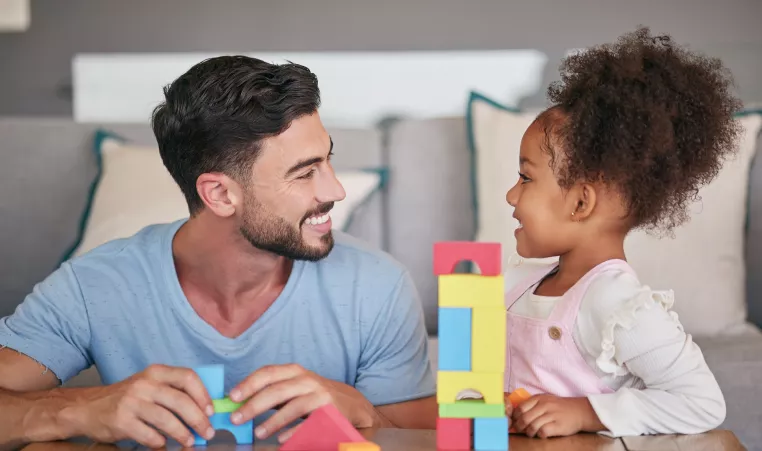What is Emotional Regulation

Have you heard the phrase emotional regulation recently and are curious to learn what it means? Or, perhaps you've vowed to have less yelling and more connecting in your family this year.
No matter what your motivation, learning more about emotional regulation can be helpful for your family - and yourself!
Emotional Regulation - The Basics
We all experience a variety of feelings throughout the day. At times, big emotions rise quickly and seemingly out of nowhere - and can disrupt your day. The key to emotional regulation is being able to recognize emotions and determine strategies to keep each in check.
Emotional regulation is important for all members of your family. As a caregiver, the youngest members of your family will need your help - especially as they learn to recognize and name their feelings. You also want to be aware of your child's emotional state as a means to avoid major disagreements or meltdowns.
Good news! You may already be practicing emotional regulation to some degree - without realizing it. For example, if you notice that your child comes home from school feeling frustrated, hungry or overly tired, you probably won't start a major school project or have a serious family discussion at that moment. Instead, you'll ask your child to take a break and have a snack. That's emotional regulation in action.
All Emotions are Useful
To be clear, emotional regulation is not about hiding away negative emotions. In fact, there aren't any bad emotions. All emotions are useful and have a purpose.
Instead of hiding big feelings, emotional regulation will allow you to become aware of how you and your children feel throughout the day. In time, you will be able to recognize and respond to big feelings like anger, frustration and disappointment - before a major meltdown occurs!
Putting it Into Practice
Emotional regulation may sound nice, but will it work in reality? Like many processes, emotional regulation is a practice that takes time to learn. Below are a few steps to get you started. Be prepared to give your family time to learn and adjust.
- Create a Stoplight of Emotions
Red, yellow, and green are commonly understood colors that can guide your family's journey toward regulation. Make this a family project, each taking a sheet of paper and drawing a stop light.
Color one level green, one level yellow and one level red. Then, label each level of the stoplight with corresponding feelings. The goal is to help each member of the family recognize when they are feeling green vs. red.
For example, you may write "calm" in the green level, "annoyed" in the yellow level and "angry" in the red level. The words can be unique to each member of your family - and there can be multiple feelings for each level of the stoplight.
- Notice and Document Signs for Each Color
Next, help your family members notice signs that indicate when they are feeling each emotion. The goal is to recognize your emotions so that you can respond appropriately.
For example, you may write "relaxed body, slow breathing and calm voice" in the green level, "tight jaw, wrinkled forehead and tense voice" in the yellow level and "out of control body, loud breathing and tight fists" in the red level. The words can be unique to each member of your family to teach each person how to identify their own feelings.
- Determine and Document Strategies for Each Color
Once you have labeled feelings and descriptive words for each color of the stoplight, you are ready to determine regulation strategies. In other words, what can you do when you are feeling red to calm down? Or what can you do if you are feeling yellow to respond to your needs so that you don't end up feeling red?
For example, if you are feeling yellow, you might need to take a break, go for a walk around the block or read for 10 minutes to help calm yourself. But if you're feeling red you may need more intense coping strategies. You may need to sing along to music in your room instead of reading. Or go for run, jump on a trampoline or kick a soccer ball into a net - instead of going for a walk.
- Use your Stoplights as a Guide
Hang up your stoplights in a useful location so that your family can easily see them. You'll want to refer to the stoplights each day, gently reminding each other when you notice signs of dysregulation.
For example, if your children are playing a game and you start to notice that their voices have become tense, you can point this out and suggest that they take a break for five minutes to get a drink of water or do some jumping jacks.
Their game will be waiting for them when they return. You can further help them by setting a five-minute timer on your phone to reassure them that they can come back to the game once they hear the timer.
Emotional Regulation for Caregivers
The final and most important note about emotional regulation is that it matters for caregivers as much as for children. It is challenging to regulate your child's emotions if you are not regulated yourself.
Modeling is one of the most important teaching tools we have as caregivers. If your child sees you modeling emotional regulation, they will be encouraged to do the same.
No one expects you to be perfect at this. It is an ongoing practice - so just try to get better at it over time.